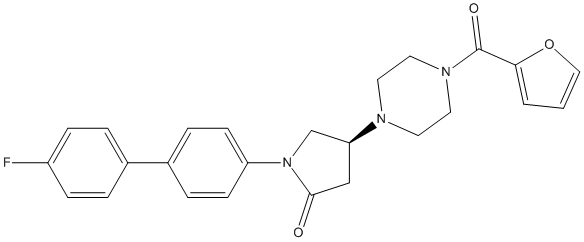YH149
(IC50= 12 nM) [18F]PF06795071 developped as a reversible MAGL PET probe
General
Type : Pyrrolidine,Piperazine,PET probe
Chemical_Nomenclature : (4~{R})-1-[4-(4-fluorophenyl)phenyl]-4-[4-(furan-2-ylcarbonyl)piperazin-1-yl]pyrrolidin-2-one
Canonical SMILES : C1CN(CCN1C2CC(=O)N(C2)C3=CC=C(C=C3)C4=CC=C(C=C4)F)C(=O)C5=CC=CO5
InChI : InChI=1S\/C25H24FN3O3\/c26-20-7-3-18(4-8-20)19-5-9-21(10-6-19)29-17-22(16-24(29)30)27-11-13-28(14-12-27)25(31)23-2-1-15-32-23\/h1-10,15,22H,11-14,16-17H2\/t22-\/m1\/s1
InChIKey : HVVLTSHAUJYILM-JOCHJYFZSA-N
Other name(s) : 81I,GLXC-25289,YH-149
MW : 433.48
Formula : C25H24FN3O3
CAS_number :
PubChem : 162624754
UniChem : HVVLTSHAUJYILM-JOCHJYFZSA-N
IUPHAR :
Wikipedia :

Target
Families : YH149 ligand of proteins in family: Monoglyceridelipase_lysophospholip
Stucture : 7PRM Crystal structure of human monoglyceride lipase with compound 13, YH149
Protein : human-MGLL
References (3)
| Title : Proof-of-concept optimization of a copper-mediated (18)F-radiosynthesis of a novel MAGL PET tracer on a high-throughput microdroplet platform and its macroscale translation - Lu_2023_Lab.Chip__ |
| Author(s) : Lu Y , He Y , Schibli R , Mu L , van Dam RM |
| Ref : Lab Chip , : , 2023 |
| Abstract : Lu_2023_Lab.Chip__ |
| ESTHER : Lu_2023_Lab.Chip__ |
| PubMedSearch : Lu_2023_Lab.Chip__ |
| PubMedID: 37818614 |
| Title : Development of High Brain-Penetrant and Reversible Monoacylglycerol Lipase PET Tracers for Neuroimaging - He_2022_J.Med.Chem_65_2191 |
| Author(s) : He Y , Schild M , Grether U , Benz J , Leibrock L , Heer D , Topp A , Collin L , Kuhn B , Wittwer M , Keller C , Gobbi LC , Schibli R , Mu L |
| Ref : Journal of Medicinal Chemistry , 65 :2191 , 2022 |
| Abstract : He_2022_J.Med.Chem_65_2191 |
| ESTHER : He_2022_J.Med.Chem_65_2191 |
| PubMedSearch : He_2022_J.Med.Chem_65_2191 |
| PubMedID: 35089028 |
| Gene_locus related to this paper: human-MGLL |
| Title : Development of reversible monoacylglycerol lipase PET tracers with improved brain uptake - He_2021_Nucl.Med.Biol_96-97_S36 |
| Author(s) : He Y , Schild M , Grether U , Humm R , Keller C , Schibli R , Gobbi L , Mu L |
| Ref : Nucl Med Biol , 96-97 :S36 , 2021 |
| Abstract : He_2021_Nucl.Med.Biol_96-97_S36 |
| ESTHER : He_2021_Nucl.Med.Biol_96-97_S36 |
| PubMedSearch : He_2021_Nucl.Med.Biol_96-97_S36 |
| PubMedID: |